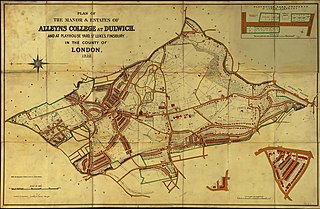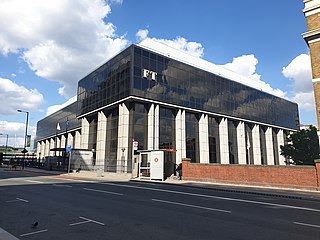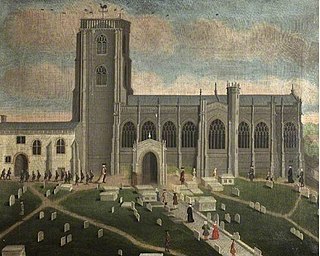Related Research Articles

Southwark is a district of Central London situated on the south bank of the River Thames, forming the north-western part of the wider modern London Borough of Southwark. The district, which is the oldest part of South London, developed due to its position at the southern end of the early versions of London Bridge, the only crossing point for many miles.

Dulwich is an area in south London, England. The settlement is mostly in the London Borough of Southwark, with parts in the London Borough of Lambeth, and consists of Dulwich Village, East Dulwich, West Dulwich, and the Southwark half of Herne Hill. Dulwich lies in a valley between the neighbouring districts of Camberwell, Crystal Palace, Denmark Hill, Forest Hill, Peckham, Sydenham Hill, and Tulse Hill.

Dulwich College is a 2–18 independent, day and boarding school for boys in Dulwich, London, England. As a public school, it began as the College of God's Gift, founded in 1619 by Elizabethan actor Edward Alleyn, with the original purpose of educating 12 poor scholars. It began to grow into a large school from 1857, and took its current form in 1870 when it moved into its current premises.

Southwark Cathedral or The Cathedral and Collegiate Church of St Saviour and St Mary Overie, Southwark, London, lies on the south bank of the River Thames close to London Bridge. It is the mother church of the Anglican Diocese of Southwark. It has been a place of Christian worship for more than 1,000 years, but a cathedral only since the creation of the diocese of Southwark in 1905.

Edward "Ned" Alleyn was an English actor who was a major figure of the Elizabethan theatre and founder of the College of God's Gift in Dulwich.

St. Olave's Grammar School is a selective secondary school for boys in Orpington, Greater London, England. Founded by royal charter in 1571, the school occupied several sites in Southwark, before establishing a location on Tooley Street in 1893. It moved to the suburb of Orpington in 1968, and has admitted girls to its sixth form since 1998.

Alleyn's School is a 4–18 co-educational, independent, Church of England, day school and sixth form in Dulwich, London, England. It is a registered charity and was originally part of Edward Alleyn's College of God's Gift charitable foundation, which also included James Allen's Girls' School (JAGS) and Dulwich College.

The College of God's Gift, often referred to as the Old (Dulwich) College, was a historic charity founded in 1619 by the Elizabethan actor and businessman Edward Alleyn who endowed it with the ancient Manor of Dulwich in south London. In 1857 it was renamed as Alleyn's College of God's Gift. The charity was reorganised in 1882 and again in 1995, when its varied component activities were split up into separate registered charities. The former constituent elements of College of God's Gift, which have been independent charities since 1995, are:

The Dulwich Estate, previously the Estates Governors of Alleyn's College of God's Gift at Dulwich, is a registered charity in England, one of the successors to the historic charity Edward Alleyn's College of God's Gift that was founded in 1619. It owns the freehold of around 1,500 acres (6.1 km2) in Dulwich, South London, including a number of private roads and a tollgate. The estate properties range from Regency and 19th century buildings to distinguished modernist 1960s buildings.
Alfred James Carver was a noted educationalist and cleric who was Master of Dulwich College from 1858 to 1883.

Rivington and Blackrod High School in the North West region of England is a Leverhulme Trust multi-academy school alongside Harper Green School, it operates as a Church of England teaching environment with a sixth form school. The school is located at two sites, with the upper school situated on Rivington Lane in Rivington, Lancashire, and the lower school situated on Albert Street in Horwich, Greater Manchester.

Southwark St Saviour was a civil parish in the metropolitan area of London, England, and part of the ancient Borough of Southwark. It was formed in 1541 from the union of the parishes of St Margaret and St Mary. It was abolished in 1930, however residents of the former parish receive a rebate against local taxation because of the presence of Borough Market. It included the Liberty of the Clink which was a special jurisdiction until 1889.

St Saviour's and St Olave's Church of England School is a secondary school and sixth form for girls located on New Kent Road near Elephant and Castle, in the London Borough of Southwark, England. It is a voluntary aided Church of England school in the Anglican Diocese of Southwark and is affiliated to the Woodard Schools group.

St Olave's Church, Southwark was a church in Southwark, England which is believed to be mentioned in the Domesday Book of 1086. It was located on Tooley Street which is named after the church, i.e. 't'olous'. It became redundant in 1926 and was demolished. It is now the location of St Olaf House, which houses part of the London Bridge Hospital.
Roger Clifford Carrington (1906–1971) was an English classical scholar, archaeologist and teacher. He was headmaster of St. Olave's and St. Saviour's Grammar School for Boys from 1937 to 1970.

Nantwich Grammar School, later known as Nantwich and Acton Grammar School, is a former grammar school for girls and boys in Nantwich, Cheshire, England. It now forms part of the mixed comprehensive school, Malbank School and Sixth Form College.

John Melhuish Strudwick, was a British Pre-Raphaelite painter.
St Margaret was a parish in the ancient borough of Southwark, located south of the River Thames in the Brixton Hundred of Surrey. It was abolished in 1541 during the Dissolution of the Monasteries and replaced with the parish of St Saviour. The parish church was located on what is now Borough High Street and the area now forms part of the London Borough of Southwark. It was from 1444 governed by the Guild of the Assumption of St Margaret's Church.

Yeovil Grammar School was a grammar school in Yeovil, Somerset, which was founded or refounded about 1860 and closed in 1906 when its only headmaster, Henry Monk, retired.
References
- ↑ "Artists: Strudwick John Melhuish". Geometry.Net. Retrieved 20 August 2012.
- Carrington, R. C. Two Schools: A History of the St. Olave's and St. Saviour's Grammar School Foundation (London: The Governors of the St. Olave's and St. Saviour's Grammar School Foundation, 1971).
- The Diocese of Southwark. "Southwark Cathedral: History." April 28, 2004, (May 2, 2004).
- Sanda Lipton Antique Silver. Source of information on the school medal. "Sanda Lipton - Index of Badges, Prizes and Masonic Medals" May 12, 2006.